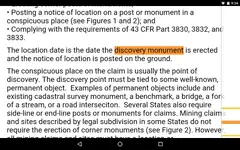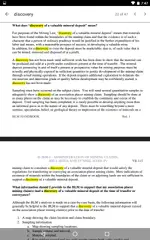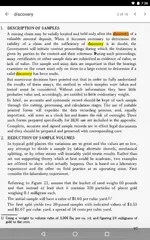This is what is required by the BLM to prove a discovery of a valuable mineral deposit. It is what is required in Court if the validity of your claim is disputed.
Notes on General Practice
Publication Info:
Placer Examination - Principles and Practice
Technical Bulletin 4 Bureau of Land Management
Table of Contents
1. DESCRIPTION OF SAMPLES
A mining claim may be validly located and held only after the discovery of a valuable mineral deposit. When it becomes necessary to determine the validity of a claim and the sufficiency of discovery is in doubt, the Government will initiate contest proceedings during which the testimony is given by parties to the contest and their witnesses. During such proceedings, assay certificates or other sample data are submitted as evidence of value, or lack of value. The sample and assay data are important in that the hearings examiner or the court must rely on them to a large extent to determine if a valid discovery has been made.
But numerous decisions hl\ve pointed out that in order to fully understand the results of these assays, the method in which samples were taken and tested must be considered. Without such information they have little probative value and, accordingly, are entitled to little evidentiary weight.
In brief, an accurate and systematic record should be kept of each sample through the cutting, processing, and calculation stages. The use of suitable printed forms will expedite the data recording process, and, equally important, will serve as a check list and lessen the risk of oversight. Three such, forms prepared specifically for BLM use are included in the appendix.
Complete, accurate and signed sample records are in effect legal documents and they should be prepared and preserved with corresponding care.
2. REDUCTION OF SAMPLE VOLUMES
In typical gold placers the variations are so great and the values are so low, any attempt to divide a sample by taking alternate shovels, mechanical splitting, or by other means will invariably yield erratic results. Rather than set out supporting theory which at best would be academic, two examples are offered to show what actually happens. One is based on a laboratory experiment and the other on field practice at an operating mine. First consider the laborabory experiment.
The foregoing examples show that the splitting of gold placer samples should be strictly avoided unless there is some very special reason to divide a sample or reduce its volume before washing or other treatment. In cases where this must be done, the mineral examiner should be fully aware of the erratic and probably misleading results likely to follow. Any divergence from normal procedure should, of course, be noted in the sampling records and in subsequent reporting.
When dealing with fine-size placer materials having a low unit-value, such as magnetite or ilmenite sands, a substantial reduction of the bulk sample or of its concentrate by mixing and splitting is generally a proper procedure and a common practice.
3. REPORTING VALUES
In the United States, the volume of placer material is always reported as bank-measure cubic yards and the value is customarily reported as cents per cubic yard.
In addition to the calculated value, the actual weight of gold in milligrams, its fineness or estimated fineness, and the price of gold used in the value calculation should be noted on the sample sheets as well as in subsequent reporting.
Minerals other than the precious metals are reported as pounds per cubic yard, percent, or the particular unit customarily used for the commodity in question.
4. COST ESTIMATES
One of the mineral examiner's functions is to give a qualified or expert opinion as to whether a given mining claim or mineral deposit has present or potential value. Among the evidence to he examined and weighed in forming his judgement will the question of costs. In many cases there is a factor so ohviously weak that a detailed cost study is not necessary, in fact, it would he useless. Here, a rough approximation hased on experience and common sense will usually suffice.
But in other cases a careful consideration of this question will he necessary. If the deposit has not he en completelyhlocked out and sampled, or if the mining method and working rate have not heen firmly estahlished, an accurate cost estimate is not possihle. Iri the absence of such development work, all the mineral examiner can do is to make a qualified estimate hased on comparative data from reliahle sources, or from his own experience with similar properties.
Basically, he must decide whether the deposit contains enough gold or other salable mineral to cover:
Cost of operation.
Cost of all equipment.
Royalties or cost of land.
All exploration, sampling, and pre-operating costs.
Cost of borrowed captial.
Cost of start-up delays and contingencies.
Reasonable profit.
In turn, some of the factors influencing the operating cost will he:
Type of operation (dredge, hydraulic, sluiceplate, etc.)
Size and tenor of the deposit.
Character of the gravel and bedrock.
Water supply.
Grade for sluices.
Disposal area for tailings and muddy water.
Working season.
Regulatory laws (land restoration, etc.)
If the foregoing are kept in mind and weighed intelligently, a fair cost estimate can usually he made hy comparing the subject property with a similar property where mining operations have heen conducted and costs established. But just how to obtain these cost data and how to equate them to today's inflated prices is one of the practical problems encountered in applying the comparative cost method.
First, we find that because of the depressed state of the placer mining industry there are few operations from which up-to-date costs might he extracted. Second, anyone who has tried to obtain detailed cost data from a responsible operating company has soon found that such information is considered confidential and seldom released for outside use. While the small operator may be freer with his information, it will usually be found that he did not bother to keep systematic records and his cost figures may be little more than a guess.
This means that for the most part, the mineral examiner will have to rely on the few placer cost data available in the technical press, most of which are fragmental and over 30 years old. A list of the more useful and readily available sources has been placed at the end of this section.
To update the older figures, a year-by-year cost index will be needed. The annual index for various classes of construction, construction materials, lahor, and machinery can be ohtained from Engineering News-Record magazine. The March (quarterly review) issue will he found particularly helpful.
In the absence of comparative data the estimator is on his own. In such cases he may have to work up estimated costs based on a hypothetical operation using a method or coinhination of methods proven effective in similar deposits elsewhere. This estimating procedure has been illustrated by Staley and Storch in a two-part article titled "Choosing a mining method for gold-hearing gravels." This article has heen listed among the selected references which follow.







 sorry Mod's
sorry Mod's
